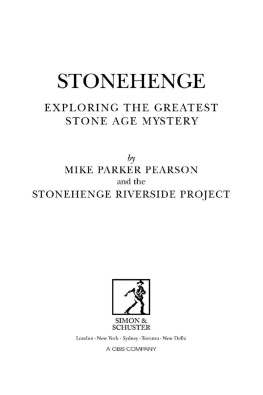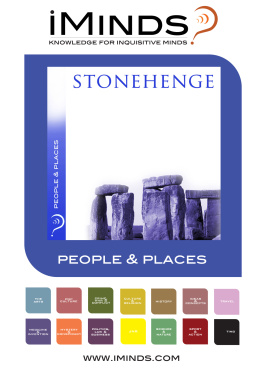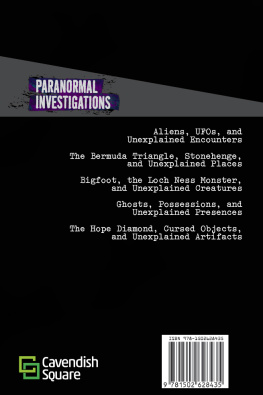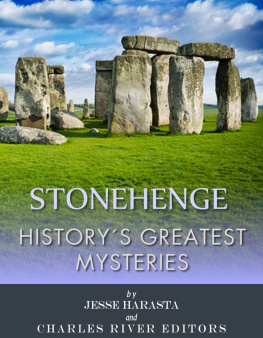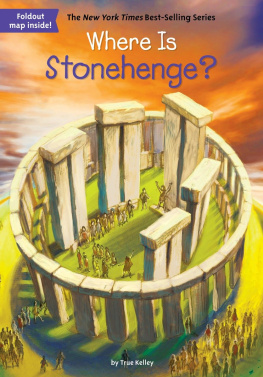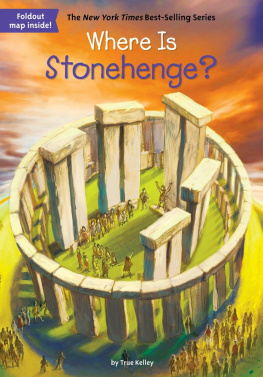PRAISE
__________
Renowned archaeologist Pearson presents the findings of the most ambitious and scientifically informed investigation of Stonehenge thus far... The most authoritative, important book on Stonehenge to date.
Kirkus Reviews , starred
This is brilliantly written scholarship. The book combines old ideas about the circle with the unexpected revelations of today. It is a triumph.
Aubrey Burl, author of A Brief History of Stonehenge and seven other books on prehistoric stone circles
From 2003 to 2009, the archaeologist Mike Pearson led the Stonehenge Riverside Project.... His book is a detailed account of that archaeological survey, expressed in a genial style that invigorates the story of the groundwork.
Iain Finlayson, The Times (London)
The book describes one of the outstanding archaeological projects of recent years. It is accessible, original, carefully researched and important. But, above all, it is exciting.
Richard Bradley, Reading University

BECAUSE EVERY BOOK IS A TEST OF NEW IDEAS
STONEHENGE
A New Understanding
Solving the Mysteries of the Greatest Stone Age Monument
by
MIKE PARKER PEARSON
and the
Stonehenge Riverside Project

New York
Also by MIKE PARKER PEARSON
__________
From Machair to Mountains: Archaeological Survey and Excavation in South Uist (2012)
Pastoralists, Warriors and Colonists: The Archaeology of Southern Madagascar (2010)
Ancient Uists: Exploring the Archaeology of the Outer Hebrides (2008)
From Stonehenge to The Baltic: Living with Cultural Diversity in the 3rd Millennium BC (2007)
Warfare, Violence and Slavery in Prehistory (2005)
South Uist: Archaeology and History of a Hebridean Island (2004)
Fiskerton: An Iron Age Timber Causeway with Iron Age and Roman Votive Offerings: The 1981 Excavations (2004)
Food, Culture and Identity in the Neolithic and Early Bronze Age (2003)
In Search of The Red Slave: Shipwreck and Captivity in Madagascar (2002)
Earthly Remains: The History and Science of Preserved Bodies (2001)
The Archaeology of Death and Burial (1999)
Between Land and Sea: Excavations at Dun Vulan, South Uist (1999)
Looking at the Land: Archaeological Landscapes in Eastern England: Recent Work and Future Directions (1994)
Architecture and Order: Approaches to Social Space (1994)
Bronze Age Britain (1993)
New Approaches to Our Past: An Archaeological Forum (1978)
STONEHENGEA NEW UNDERSTANDING: Solving the Mysteries of the Greatest Stone Age Monument
Copyright 2011, 2013 Mike Parker Pearson
The are a continuation of this copyright page.
All rights reserved. Except for brief passages quoted in newspaper, magazine, radio, television, or online reviews, no portion of this book may be reproduced, distributed, or transmitted in any form or by any means, electronic or mechanical, including photocopying, recording, or information storage or retrieval system, without the prior written permission of the publisher.
The Experiment, LLC
260 Fifth Avenue
New York, NY 100016408
www.theexperimentpublishing.com
StonehengeA New Understanding was first published as Stonehenge in the United Kingdom in 2012 by Simon & Schuster UK Ltd.
The Experiments books are available at special discounts when purchased in bulk for premiums and sales promotions as well as for fund-raising or educational use. For details, contact us at .
Many of the designations used by manufacturers and sellers to distinguish their products are claimed as trademarks. Where those designations appear in this book and The Experiment was aware of a trademark claim, the designations have been capitalized.
Library of Congress Cataloging-in-Publication Data:
Parker Pearson, Michael, 1957
Stonehenge : a new understanding : solving the mysteries of the greatest stone age monument / by Mike Parker Pearson and the Stonehenge Riverside Project.
pages cm
First published in Great Britain in 2012 as Stonehenge : exploring the greatest stone age mystery by Simon & Schuster, a division of Simon & Schuster UK Ltd.--T.p. verso.
Includes bibliographical references and index.
ISBN 978-1-61519-079-9 (hardcover) -- ISBN 978-1-61519-172-7 (ebook)
1. Stonehenge (England)--History. 2. England--Antiquities. 3. Megalithic monuments--England. 4. Stonehenge World Heritage Site (England) I. Stonehenge Riverside Project (England) II. Title.
DA142.P37 2013
936.2'319---dc23
2012047688
ISBN 978-1-61519-079-9
Ebook ISBN 978-1-61519-172-7
Jacket design by Christine Van Bree
Jacket photograph Skyscan | Corbis
Back cover illustration by Matt Johnson | S&S Art Department
Author photo courtesy University of Sheffield
Manufactured in the United States of America
Distributed by Workman Publishing Company, Inc.
Distributed simultaneously in Canada by Thomas Allen & Son Ltd.
First published May 2013
10 9 8 7 6 5 4 3 2 1
CONTENTS
__________
INTRODUCTION
__________
For millennia Stonehenge has stood alone on Salisbury Plain, a mysterious legacy of a vanished culture. Today it is flanked by two busy roads, and its visitor center attracts almost a million tourists a year from all around the world. Yet only fifty years ago it was still a quiet and empty place, reached by lonely roads and tracks over the high plain. A visiting Dutch archaeologist described it in 1957: There was no fence nor were tickets sold at Stonehenge, and there were no other visitors, the car was just parked on the grass and you could just walk around the stones and touch them.
The myth of Stonehenge in seclusion is a powerful one. Many have tried to understand Stonehenge on its own, without thinking greatly about its surroundings on the windswept plain, or the people of its wider world. Astronomers, mathematicians, engineers, and all manner of scholars and enthusiasts have pored over plans and drawings of this great stone circle, extracting significance from myriad possible interpretations of its design. In the modern era, many of those interested in the monument have certainly hoped that some secret code to its meaning might somehow be brokenif only we knew how.
If we could travel back in time, some 4,000 or 5,000 years, we would find that Stonehenge was not an isolated marvel. It was one of many monuments in this part of Salisbury Plain. Some were built of timber, and lasted only a few centuries. At least one monument of stone standing on the bank of the nearby River Avon was dismantled by ancient people only a few centuries after it was put up. The banks and ditches of large earthwork enclosures lasted much longer, but millennia of plowing and erosion have reduced them to mere humps and bumps that are barely visible today. Stonehenge in its heyday was thus not alone, being part of a landscape teeming with construction and activity. For those studying Stonehenge, therefore, the stone circle is not in itself the puzzle but rather just one piece of a complex jigsaw.
For more than three hundred years people have been trying to find that puzzles missing pieces. In 1666 John Aubrey, the kings antiquary, discovered that there was an avenue leading from Stonehenge toward the River Avon, which runs to its east. In the 1720s the antiquarian William Stukeley recorded many details about Stonehenge and its surrounding burial mounds, or barrows. Eighty years later, local landowner Richard Colt Hoare, the excavator of many of these barrows, mapped a huge earthwork enclosure, known as Durrington Walls, that is situated some two miles northeast of Stonehenge. The pace of discovery quickened during the twentieth century, as the footprints of long-vanished timber circles at Durrington Walls and the nearby site called Woodhenge were excavated by teams of expert archaeologists.


